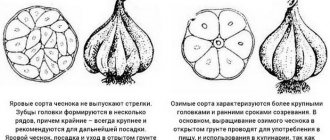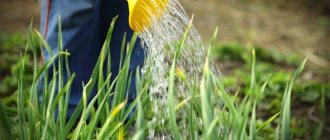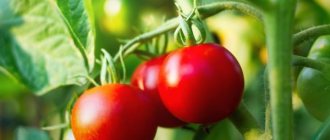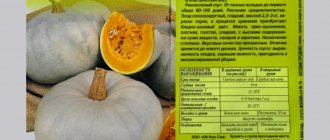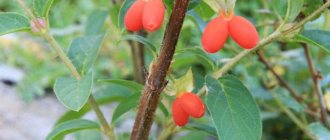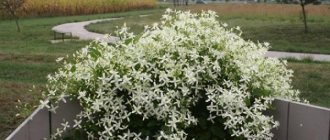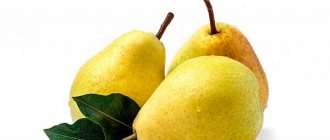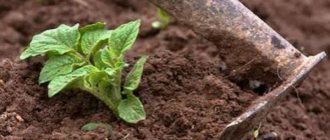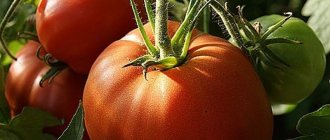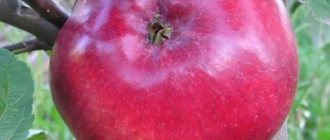The garlic variety Lyubasha is one of the most popular for planting before winter. It is grown throughout the country and is praised for such qualities as unpretentiousness, high yield, resistance to drought, some diseases and pests, and excellent component composition.
garlic variety "Lyubasha"
variety "Lyubasha" is characterized by high yield
Winter garlic "Lyubasha" stores well
Description and characteristics
Lyubasha is a universal variety, suitable for salads and other dishes, making preparations for the winter. Stable harvest. Does not place high demands on care and soil composition. Winter garlic is frost-resistant and has excellent storage qualities. Lyubasha has a powerful root system. The foliage is emerald with a light waxy coating. The leaves are long and densely packed.
Variety characteristics:
| Index | Meaning |
| Head weight | 100-150 g or more |
| Bush height | 120-150 cm |
| Teeth color | cream |
| Number of teeth | 5-10 |
| Clove weight | 10-20 g |
| Ripening period | 85-95 days |
| Transverse bulb diameter | 6-7 cm |
| Productivity per hectare | 15-20 t |
Botanical features of the Lyubasha variety
The shoots of Lyubasha garlic grow to a maximum of 1.5 m. The average size of the crop is 1–1.2 m. The green leaves are narrow (2–2.5 cm) and long (40 cm). The heads, whose weight ranges from 60 to 350 g, are more often born 100 grams and are covered with white scales with purple stripes. One commercial head consists of 4–7 pale cream teeth.
Lyubasha is a medium-ripening variety of garlic with a pungent taste and a persistent aftertaste. The vegetable ripens within 3 months from the moment of germination.
Pros and cons of Lyubasha
The winter variety has a number of advantages, and they make it attractive to gardeners:
- Excellent drought and frost resistance.
- The product contains high levels of vitamin C, proteins, amino acids, essential oils, selenium and other substances.
- Stable and high yield.
- Tolerance to fungal diseases and resistance to pests.
If there is not enough snow, garlic may freeze; it is necessary to mulch the soil. In the warm season, Lyubasha requires a sunny place; in the shade this variety does not develop well enough. But when agrotechnical requirements are met, it produces excellent yields. There are no significant disadvantages mentioned.
Farmer reviews
Reviews about Lyubasha garlic are mostly positive . It is praised and admired for its frost resistance, drought resistance and stable yield.
Here are just a few reviews:
Alexandra: “Last year we bought Lyubasha garlic from a private owner at the market for winter planting. The garlic was small, approximately the same size and almost all had four cloves. Today we have harvested. Garlic has up to seven cloves in the head, and the weight reaches 120 g. The taste is excellent, and so is the keeping quality.”
Mikhail: “It may, of course, be a good year for garlic, but the Lyubasha variety just made us happy. Minimal care, moderate watering, loosening the soil. There was only one fertilizing with nitrogen fertilizer in early spring, no more chemicals. I grew 490 kg of garlic and found sales at the local wholesale market in Vinnitsa.”
Where can I buy planting material?
Ready-made planting material for Lyubasha garlic can be purchased at any open trading platform: in an online store or from individuals. On average, garlic for planting (not commercial) costs from 500 rubles per kg. On farms they sell 1 kg of bulbs for 200-300 rubles. (farms in the Belgorod, Tver, Tula regions, Moscow region, etc.).
If you buy garlic bulbs for planting, the goods will cost an average of 1000-1500 rubles per kg. Bulbs are also sold individually: from 10 rubles for 10 pieces. (for example, in stores in the Moscow region). The cost of an elite product is many times higher.
Prevention of various problems
During the growing season:
- Slow feather growth. This means that the plant does not have enough nutrition, it needs to be fed with the composition - 1 tablespoon of urea and 1 glass of bird droppings per 10 liters of water.
- Gray-white feathers - not enough moisture.
- The pale green tint is due to excess moisture, limit watering.
- Feathers do not grow and turn yellow:
- lack of nutrition;
- excessive or insufficient humidity;
- freezing in winter;
- soil acidity;
- pests or diseases.
Garlic planting time
Lyubasha is planted in the fall and is a winter variety. Suitable for planting are seed bulbs (balloons), single-toothed seeds grown in the second year, or ripened heads. The optimal planting period is October (until mid-November), a few weeks before the first frost. This time will be enough for the garlic to get used to outdoor conditions. If garlic is planted in the spring, this is done before mid-April - the material is placed in soil that is moist after the snow has melted.
Lyubasha takes root well in different climatic zones - both in the south and in the north. Suitable for small farms in the Moscow region. It is advisable to choose planting material in the area where it is planned to be planted.
Soil preparation
Lyubasha is not picky about the soil, but the gardener still needs to prepare the soil for planting garlic:
- dig up the soil efficiently, giving it airiness;
- loosen at a depth of about 30 cm;
- remove all debris, stones, grass from the ground in the process;
- Dig the furrows 2-3 weeks before the intended planting, add the necessary fertilizers: natural and industrial with potassium or phosphorus;
- Water the holes thoroughly 2-3 days before planting.
The landing material is also inspected for defects. Only good, unsprouted bulbs and bulbs are selected. Garlic cloves are taken from the three-lobed heads. It is recommended to soak them for 30 minutes in potassium permanganate to disinfect.
Winter crop yield
The productivity of Lyubasha garlic depends on care and favorable weather conditions. Even in dry summers, the variety produces up to 35 centners of vegetables per hectare .
Increases productivity by removing 10-centimeter shoots and applying fertilizers. Depending on the region, bulb harvesting lasts from the last ten days of June to the end of July. When performing all agrotechnical work, gardeners receive 2–3 kg of bulbs per 1 sq.m.
Step-by-step planting instructions
Winter garlic is sown in rows with an interval of 35-45 cm. There is a step between plantings, since Lyubasha is a large garlic and it requires a lot of space. The holes are deepened by 5-9 cm. Wood ash is usually poured onto their bottom and the entire row is filled with warm water. Next, planting material is placed.
Planting pattern:
- The teeth and single teeth deepen by 7 cm or more.
- The bulbs have a depth of 4-5 cm.
The cloves planted in the holes are sprinkled with soil. The furrows are not watered, but covered with spruce branches, straw, sawdust, peat or thin branches (i.e. mulched). This is especially true for regions with harsh climates, otherwise garlic may not survive the winter. The covering material is removed when the snow melts.
How to plant this variety correctly
Before you start planting garlic, you need to properly prepare the area. The soil should be thoroughly loosened and leveled using a rake. Old roots, plant debris and stones are removed. Ash or organic fertilizers are added to the soil.
Healthy cloves for planting
In order for garlic to sprout quickly, you need to follow some simple planting rules:
- The garlic heads are divided into teeth.
- The garlic is inspected for signs of disease. Teeth with symptoms of rot and mold are removed. Also, planting material that has traces of mechanical damage is not used for cultivation.
- The teeth are soaked for 30 minutes in a light solution of manganese (this will reduce the risk of diseases).
- The plant is planted in mid-September. Small holes are formed in the prepared area.
- Garlic cloves are immersed in the soil to a depth of 7 cm, at a distance of 30 cm from each other. This will not only make the process of caring for the crop easier, but will also make the heads large.
- Plantings are sprinkled with soil and insulated with mulch. The latter is used fallen leaves, straw or peat with sawdust.
Straw mulch
The culture can propagate using seeds. Garlic bulbs of the Lyubasha variety are distinguished by their large grain sizes. They are fully ripe by mid-June.
To plant, you need to carefully cut off the bulbs and place them in the sun to dry for several days. After the seeds have dried, the planting material is placed in a cardboard box and stored until autumn
In the fall, at the end of September, you need to make small beds and plant garlic. Sprouts will appear in the spring, but to obtain heads you need to plant the plant in the ground for 2 years. One-toothed trees do not need to be dug up from the ground, but in order for the fruits to be large, it is recommended to plant them in a different place in the second year.
After planting, the crop requires virtually no maintenance: it is enough to promptly remove weeds and loosen the soil to saturate it with oxygen.
Garlic seeds
Each gardener can choose the most suitable method of propagating the crop individually, depending on personal preferences.
It is also important to observe crop rotation to increase productivity. It is recommended to plant the variety after crops such as legumes, melons
It is these plants that saturate the soil with the substances necessary for the rapid growth of garlic.
The winter variety of garlic Lyubasha (Lyubava) is very popular among gardeners, because it is grown with equal success on different soils. The advantage of the plant is its high yield and easy care. Its garlic taste is sharp and bright, which allows the product to be used in all kinds of hot dishes, salads, and preparations.
Caring for Lyubasha
Caring for garlic includes regular watering, weeding and fertilizing.
Regularity of watering
The regularity and abundance of watering is determined by the temperature and ripening period of the garlic. Starting from the first days of April until the third ten days of June, when the garlic puts out young shoots - arrows, the beds are abundantly moistened so that the soil does not dry out. In summer, you can reduce watering to 1-2 times a week. The pale green color of the leaves may indicate excess moisture.
The ripening period for Lyubasha is 3 months after the first shoots. Two weeks before final ripening, watering is completely stopped to allow the soil to dry out. This makes harvesting easier.
Feeding
Lyubasha, like other varieties of garlic, benefits from getting all the necessary substances from fertilizers. In the spring, garlic is fertilized with urea, diluting 20 g of the substance in a bucket of water and watering the beds using sprinkling. For 1 sq. m area, up to 4 liters of the drug should be consumed. If feathers grow slowly, you can add bird droppings to the urea (a glass of 10 liters of water).
Fertilizing is combined with watering. Their regularity is as follows:
- Spring fertilizer with urea.
- Second feeding after 2-3 weeks. Mineral fertilizer (nitroammofoska) is diluted in 10 liters of water - 2 tbsp. spoons of the substance.
- The third - during the formation of the bulb. Phosphorus fertilizer (superphosphate) is used. The expense is the same.
Weeding and other manipulations
Timely digging of garlic beds is the key to plant health. Moisture and air flow through the loose soil to the roots and bulbs. During loosening, weeds are removed from the beds. Weeding is carried out after watering, which makes the gardener’s work easier.
In addition to weeding, garlic can benefit from manipulations such as pruning shoots. When shoots appear in June and reach a length of 9-11 cm, the shoots are pinched off. Farmers keep some of them for themselves to use the bulbs for planting. If you plan to leave the seeds, you must wait until they are fully ripe.
How to grow a crop
Lyubasha's garlic is planted in the ground 2 times a year: for the winter, in mid-October-November, and for the summer season, in mid-April. It should be understood that planting dates may vary depending on different climatic conditions and when planting, you need to focus on the air and soil temperature. About 1.5 tons of seedlings will be required per hectare of land.
See also Why and what to do if garlic rots in the garden
Garlic is a light-loving plant, so it is planted in open areas of the field, well insulated for the winter. It does not require special soil; it is enough to pre-fertilize the beds with organic matter and mineral complexes. Planting material must be treated with a weak solution of manganese.
Preparation of the site and planting material
Since garlic is not a picky plant, it does not require special conditions when planting.
However, disease prevention requires certain procedures to be carried out with soil and planting material:
- Dig the soil 30 cm deep, removing all debris and remnants of the previous harvest.
- Fertilize the soil with organic solutions and a mineral complex.
- Additionally, drain the soil with a layer of river sand.
- Level the soil and loosen it.
- Treat the seed material with a solution of manganese or copper sulfate.
- Dry the garlic cloves well.
Garlic should be sown after legumes, melons, cabbage and any greens - it is strictly forbidden to plant it after plants of the bulbous family, as it can become infected with rot or onion fly.
Expert opinion
Stanislav Pavlovich
Gardener with 17 years of experience and our expert
Ask a Question
Important! It is preferable to plant garlic on loamy soils with neutral acidity.
How and when to plant
After preparing the soil and seed, you can begin planting. For the winter, garlic is planted a month before the first frost so that the plant gets used to it and adapts, and for the summer season - in the first 2 weeks of April, while the ground is still wet from melting snow. Garlic is planted in 3 ways:
- Bulbs - seeds that form in arrows, are sorted by size and manually planted.
- Single cloves are small garlic heads that grow from seed within a year. They remain in the ground for another year, and eventually grow into full-fledged garlic heads.
- With teeth - the usual head is broken into slices, which are planted. But with this method of propagation, garlic loses its properties.
On the beds, rows are made with a distance of 30 cm, while it must be taken into account that seeds are planted every 10 cm for better development and growth. River sand is laid at the bottom of the rows for drainage and wood ash to protect against parasites. The seeds are buried 5-6 cm into the ground, while the bulbs can be planted 3 cm deep. The beds are mulched with a layer of peat, sawdust or leaves. In this case, the mulch layer should be at least 3 mm, even if the winters are snowy.
Diseases and pests
This variety of garlic is resistant to many diseases, but runs the risk of becoming infected with fungus during the growing season. For prevention purposes, it is recommended to pre-soak the cloves, spray the grown plants with fungicides, and remove damaged specimens. Lyubasha is resistant to fusarium, but is susceptible to the negative influence of other pathogenic microorganisms and pests.
| Microorganisms | Pests |
| downy mildew | stem nematode |
| bacteriosis | secretive proboscis |
| black mold | root mite |
| cervical rot | onion hoverfly |
| onion fly |
Advantages and disadvantages
- The undoubted advantages of the variety usually include:
- large fruit and, accordingly, high yield;
- resistance to frost and spring cold snaps;
- high genetic strength;
- low requirements for humidity and regularity of watering;
- high immunity to most fungal infections, especially fusarium, low susceptibility to pest attacks;
- early ripening (about 95 days from the moment of emergence, which usually means the beginning of harvesting from the third decade of June);
- high commercial qualities (due to large heads of the same shape, the variety is often grown for subsequent sale);
- excellent taste and bright aroma, allowing you to use not only the bulbs, but also the leaves of the plant;
- rich vitamin and mineral composition, providing numerous beneficial properties (the variety has no equal in the content of essential oils);
- universal purpose of bulbs;
- long shelf life (in favorable conditions, the crop can retain its external properties, taste and chemical composition for 10-11 months from the date of collection).
- Lyubasha's shortcomings are rarely discussed. For example, this list sometimes includes:
- relatively low allicin content (there are varieties of garlic in which the amount of this substance reaches 0.74%, that is, 2 times more than Lyubasha);
- launching arrows and the need for their timely removal;
- the need to mulch the beds for the winter, especially in regions with a harsh climate.
However, it should be noted that the last 2 features from the above list are characteristic of all types of winter garlic, but Lyubasha’s garlic, even if the arrows are not removed in time, still forms large heads.
Collection and storage
Lyubasha is harvested in July, preferably in dry, sunny weather. The fact that the crop is ripe is signaled by the lower leaves, which turn yellow en masse. How to harvest garlic:
- Use a shovel to dig up the heads, pull them out, and clean them.
- Leave for two hours in the shade.
- Hang it under the ceiling or outside under a canopy for a week.
- When the husks are completely dry, cut off the stems, leaving only the neck.
You can look at the Lyubasha garlic variety and learn about the features of its cultivation in the video below:
The harvested crop is placed in boxes, bags, nets, or the garlic is braided. Storage areas must be ventilated, such as a basement or any other place without direct sunlight. The optimal temperature in winter is a slight minus. In order for the garlic to survive until spring, it is sorted from time to time, examining it for the presence of diseases and rot.
History of variety selection
The Lyubasha variety was bred in Ukraine by the famous breeder from the Zaporozhye region Ivan Zakharenko specifically for cultivation in cold winter conditions. Garlic was first discovered in 1999 and over the years it has been refined and improved by a breeder. It was first officially tested at a sowing station in 2005-2007. and showed excellent results. After testing, it was officially registered in the state register and named after the breeder’s mother-in-law.
Lyubasha's garlic grows beautifully throughout Russia, in the arid Caucasus and rainy Baltic states. It is resistant to high humidity and tolerates drought, while producing an excellent healthy harvest. It is a universal variety and is suitable for consumption fresh and canned.
Reviews of garlic Lyubasha
After the first year of planting, I only had pleasant impressions about Lyubasha’s garlic. About 80 kg were collected from one hundred square meters of land. Most went for sale and winter preparations. Lyubasha loves water. If your soil is constantly moist, I do not recommend frequent watering.
★★★★★
Vladimir. I love this variety for its large bulbs and unpretentiousness.
Easy to grow! It grows well in Crimea, the local climate is ideal for Lyubasha. I don't see any flaws in the variety. I recommend it for large farms, profit is guaranteed. ★★★★★
Ilya. The garlic variety Lyubasha is well zoned, so it survives bad weather - both cold and drought, does not require special care, is immune to diseases and pests, and produces excellent yields of large bulbs.
Hide
Add your review
Lyubasha's specialty is her spicy taste. This garlic is used in home cooking and in industry. Anyone can plant a crop on their own plot with stable yields.
0
0
Copy link
Application and beneficial properties
Lyubasha garlic is grown for personal consumption and for sale, and is used in cooking and medicine.
Not only the cloves, but also the leaves of this plant are used as a food product. Young green garlic is a source of the first spring vitamins. It is put in various salads and added to first courses. The cloves are used fresh, as a seasoning for borscht, when baking meat, as an ingredient in canning vegetables and preparing hot sauces. In medicine, garlic is known for its antimicrobial, antiviral and disinfectant effects. Effective against fungal infections. It strengthens the immune system, stimulates digestion, improves heart function and prevents cholesterol from being deposited. Continued moderate consumption reduces the likelihood of blood clots.
In addition, the product is known as a simple and affordable antihistamine, as well as a multivitamin complex to support the body in the fight against diseases and during the recovery period after illnesses.
